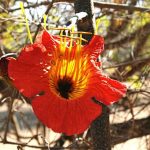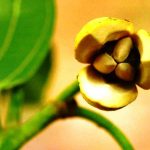TREE LIFE
November 1987
MASHONALAND CALENDAR
Tuesday November 3rd: Botanic Garden Walk. Meet at the Car Park at 1645 for 1700 hours. In November the flowering trees at the Garden are at their height, so we will no doubt take advantage of this.
Sunday November 15th: The Great Dyke Caesar Pass. The riverine dyke vegetation in this area is particularly good. We plan a round trip via Concession to the mine, returning on the Kariba road. An Express Motorways coach has been arranged leaving the Monomatapa car park at 0815 hours. Fare $2
Tuesday November 17th: Mike Bingham a well known botanist from Zambia will give a talk with slides which take place at 2000 hours at the Zoology Lecture theatre at the University of Zimbabwe.
Sunday December 20th: An informal gathering with the botanical interest focused on Ilex aquifolium, Viscum album and Cupressus spp. –i.e. a Christmas gathering at Cheryl and Phili Haxen’s “The Shambles” Helensvale, Borrowdale.
MATABELELAND CALENDAR
Sunday November 1st we will go to the Circular Drive Area, from the Old Gwanda Road, meet at the junction of these at 0830 hours.
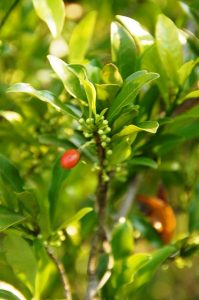
Erythroxylum emarginatum. Photo: T. Castigo. Source: Flora of Zimbabwe
On Sunday October 2nd we went to the Matopos, to the area behind Efifi, first and then around the other side. It was extremely cold and windy, so some of us doubted our sanity in proceeding. However, it turned out very well, and we even had a little sun in the afternoon, doubly welcome as we were on top of one of the larger hills very exposed at the time. We have reverted to our old practice of having talks by one or two members on specific trees. The indefatigable Ken Blake started us off with two good talks on Erythroxylum emarginatum and Peltophorum africanum, though his second was somewhat bedeviled by the miserable specimen in front of us. On the whole trees were very dry and leafless. Previously, in this area we have found some 90 varieties yet in spite of conditions we identified some 60 species. No Acacias nor Albizias were seen. Apodytes dimidiata puzzled us a bit, Catha edulis and Cassine matabelica were both well leafed, Dombeya rotundifolia had flowers already reddened, Commiphora marlothii one with so much paper bark that the green was hardly visible, several Erythroxylum emarginatum to illustrate Ken’s points, many Euclea natalensis, very few E. divinorum, lots of Euclea racemosa subsp. schimperi, Euphorbia cooperi on many of the dwalas, a completely leafless Zanthoxylum capensis, Fagara, only identified by its thorny bosses. When we wandered over the road we came upon a magnificent red Ficus ingens, just beginning to green up. Other red leaves noted were Lannea discolor and a fine Flacourtia indica. We found some very young Homalium dentatum, some big Kirkia acuminata many Mimusops zeyheri, Nuxia congesta, which we don’t often see, Osyris lanceolata, not near any fig, so perhaps not a root parasite in this case. Pittosporum viridiflorum, one solitary Protea gaguedi, Pavetta eylesii, with large leaves similar to Ficus sur, which we did not see, many Pseudolachnostylis in new bud, several small sneezewood, Ptaeroxylon obliquum, Rhus leptodictya living up to its name as Mountain or Rock Rhus, some rather dark grey barked Violet Trees, Securidaca longepedunculata, Strychnos matopensis in scrambling thickets, S. madagascariensis, and some very corky Strychnos cocculoides, Tarchonanthus camphoratus, Tarenna nerurophylla, Tarenna zimbabwensis, Teclea rogersii or Vepris reflexa, apparently difficult without a flower to decide, Ziziphus mucronata, bare but with its one up one down thorns.
-C. Sykes
AYRSHIRE NOTES – GLYN-A-MEL RE-VISITED
Following a look at the completed weir at the Glyn-a-mel site on the Manyame river some local tree enthusiasts recently re-visited a stream crossing on the Chesdale to Silverside farm road, described by Benedicta Graves in Tree Life, August 1986 as an area of “species richness totally unexpected”.
This is one of the many small streams that drain the escarpment of the Manyame range into the Manyame river. The geological map shows the country rock to be arkese, of the Shamvian system, though no doubt an enrichment of carbonates has occurred, having dissolved out of the dolomites and other rocks of the Lomagundi system that build the escarpment. Fertility apart, the obvious reason for the well developed vegetation species is the presence of perennial water, seeping throughout the year from the escarpment rocks.
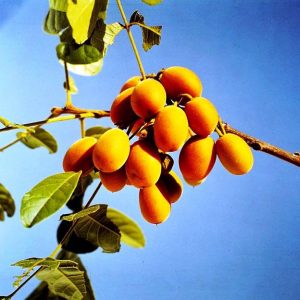
Zanha africana. Photo: Mike Bingham. Source: Flora of Zimbabwe
So we were to expect species usually associated with riverine systems, and Diospyros mespiliformis fulfilled these expectations. Very well grown, with their feet in water, they were identified mostly by bark alone. Equally well developed were a number of Zanha africana, the identification of which required strenuous efforts to gather leaf material, and more than one visit to the Herbarium. The presence of this species in this environment and of this size justified the total confusion of those present, who are more familiar with its granite kopje and ant-heap habitat. Celtis africana added to the top storey and also with their feet in water were Nuxia oppositifolia, Rauvolfia caffra and Ekebergia capensis. The under storey was well populated with Carissa edulis and Friesodielsia obovata, both in fruit, and both identified by bite.
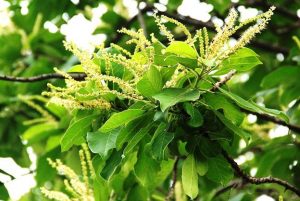
Terminalia stenostachya. Photo: Bart Wursten. Source: Flora of Zimbabwe
Standing back a little from the running water and competition for light were a number of typically riverine species : Bequaertiodendron magalismontanum, Syzygium guineense, Strychnos potatorum, Ziziphus mucronata, Cassine aethiopica, Pittosporum viridiflorum, Kigelia africana, Erythroxylum emarginatum and Garcinia buchananii.
Not so well developed and probably less affected by the available moisture, but enjoying the fertility were Peltophorum africanum, Diospyros kirkii, Albizia amara, Dalbergia melanoxylon, Combretum fragrans, Terminalia sericea and Terminalia stenostachya, Acacia goetzei and Acacia gerrardii, Cassia singueana and Cassia abbreviata,, Erythrina abyssinica, Euclea divinorum and Euphorbia ingens.
All this, and no doubt many more unnoticed species in an area of less than a hectare, is richness indeed. Regrettably the spurs of land between the streams had been cleared for cultivation, therefore the climax vegetation was difficult to ascertain. What was alarmingly evident was the invasion of these old lands with very well developed thickets of Acacia polyacantha.
-D. Henderson
OUTING TO GABAZA AND HARWEN FARMS – HARARE SOUTH, 18TH OCTOBER 1987
After most welcome refreshments provided by Ellie and Ian Burton in their beautiful garden at Gabaza farm, members grudgingly climbed back into the bus and we set off to the neighbouring farm of Mr. Laing.
The spot we had chosen was a piece of woodland by the Misike river and on arrival we were impressed by the size of the trees and the many rocky outcrops. We split into two groups, some members following Dick on the Ten Tree ramble and the others went with Phil and Meg to wander amongst the rocky outcrops and anthills.
One fascinating sight was a Ficus thonningii, the strangler fig. The seed must have landed on the rock, germinated and sent a root over the edge and down about four meters to the ground where it established itself, it then proceeded to grow upwards again strangling itself in the process.
Two trees with compound leaves which we often confuse are Burkea africana and Albizia antunesiana and although the specimens we saw were exceptionally large we were able to get some leaves to see how they differ. Burkea africana has alternate imparipinnate leaflets and has distinctive rusty coloured growing tips while Albizia antunesiana has opposite paripinnate leaflets whose under surfaces are much paler and often have reddish petioles.
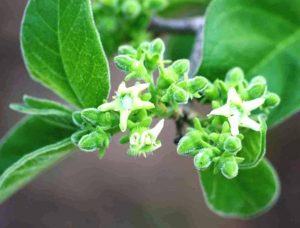
Vangueria infausta. Photo: Bart Wursten. Source: Flora of Zimbabwe
A large fruiting Boscia salicifolia growing on an anthill caught our attention. We noted the willow like leaves with very prominent and very pale mid ribs on the under surfaces. Another tree growing on the anthills was Schotia brachypetala with asymmetric leaflets and rachis often winged. Several of us puzzled over a small tree until Meg pointed to the asymmetrical fruit with the apical pore and the interpetiolar stipules which clearly indicate Vangueria infausta.
Other large trees growing amongst the rocky outcrops were Pterocarpus angolensis, P. rotundifolius, Brachystegia spiciformis and Julbernardia globiflora. An unusually tall Azanza garckeana had had a good fruiting season and although most of the ‘snot apples’ were brown and dry there were still some green ones on the uppermost branches.
In an “identify from a distance” test our two fundis were right with Pappea capensis aided they said by the general shape, pale bark of the multi stemmed trunk and the fact that P. capensis usually grows on anthills.
Diospyros lycioides with crooked growing tips and Rhus longipes were the most common of the smaller trees. Plentiful too were Gardenia volkensii in flower, Cassine aethiopica, Canthium huillense, which has been renamed Psydrax livida and Carissa edulis with paired thorns with the leaves The C. edulis were just coming to the end of their flowering period but we were lucky and found a few sweet scented little white “star’ flowers. There were several Faurea saligna with characteristic rough, dark, fissured bark. Phil found some pieces of dead F. saligna on the ground and showed us the lovely ‘snakey’ grain of the wood. The COMBRETACEAE family was represented by Combretum molle, C. zeyheri, C. collinum and Terminalia sericea, we saw two wooly galls which grow on the Combretums and the smooth galls similarly only found on Terminalia sericea.
A common sight in the bush and one that has puzzled me for a long time was explained at last. This, a pendulous mass of a fairly solid looking mixture of web and other matter and, we learnt, only ever attached to Cassia singueana, is the nest of the moth caterpillars.
As there was very little water in the river we were able to cross quite easily to explore yet another anthill before lunch. Returning to the bus with slightly quickened pace we looked at Acacia sieberiana and A. karroo both bursting with new leaf, and we paused to gaze at and admire a really huge Boscia salicifolia.
And so to lunch.
-M.S.J.
THE TEN TREE CLUB
As usual, someone had come along between the day of the recce and the day of the outing and moved all the trees that were spotted on the first occasion.
This has happened to other people as well, so there is obviously a very powerful djinn at work. Any member spotting this bogey should ignore it, in case it puts you to sleep for 100 years, or something. We can manage somehow, as we did this day.
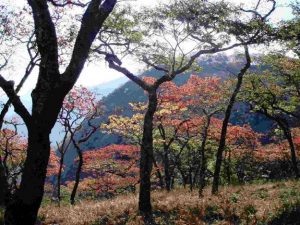
Brachystegia spiciformis. Photo: Mark Hyde. Source: Flora of Zimbabwe
Fruit seemed to be the thread that ran though our ramble. Shortly after looking at the compound leaves of Brachystegia spiciformis, msasa and the Rhus longipes, large leafed Rhus, we came across the distinctive yellow brown young leaves of Parinari curatellifolia, mbola plum. Ozoroa insignis, tarberry, with its felted leaves and veins going right to the leaf edge was followed by Diospyros lycioides, red star apple, an anthill dweller. Four of the five leaf characteristics of Diospyros were confirmed for us – sunken centre vein, shiny upper surface, hairy edge, and different sized leaves on the same branchlet. However, the edges of the leaves were not wavy in this species.
The young leaves of Terminalia sericea, silver terminalia, reaching for the sun, with braided bark, and galls to complete the identification, provided an unforgettable picture, as did the red young branches and white, fat thorns of Acacia karroo, sweet thorn.
And so back home, via Covent Garden, as we passed a small Azanza garckeana, snot apple, with its distinctive scar on the underside of the main vein, a gland?
-D.D. Henderson
After lunch, those with a small reserve of energy went walkabout again. Some of the highlights were entirely non botanical. For example a noisy population of Mocking Chats, a pair of Spotted Eagle Owls flushed from their daytime rocky roost, high flying Wahlberg’s eagle and a possible Booted eagle. Looking decidedly sleepy and I suspect a little embarrassed at having been spotted was a bush baby at the top of an Acacia karroo. Closer to the ground level were a scattering of ant-lion craters and to the delight of the children present they “performed” when fooled into thinking that an ant had stumbled over the edge.
Tree wise, we repeated a good deal of that seen earlier. But the edge of a termitarium a tangled, tall tower of intertwined twigs, though seemingly dead as a doornail in its lower parts, still bore recent evidence of having flowered at its top end. The flowers were decidedly of Steganotaenia araliacea and definitely connected to the dead tree below.
The magnitude and growth form of a Maytenus hetrophylla evidential of a very old tree. Soon after this sight a small Securidaca longepedunculata had cameras clicking and nostrils flaring to absorb the super sweet heady scent emitted from the rich violet hued flowers.
On our return to the car park we were shown leaves that were not unlike those of Securidaca longepedunculata, but bore a legume type pod. After much head scratching and flicking through botanical tomes, it was decided that this was likely to be Maerua parvifolia, a shrub not quite a “tree” and therefore not in Trees of Southern Africa.
-J.P. Haxen
NOTES IN LIEU OF THE BOTANIC GARDEN WALK – OCTOBER 1987
This month’s botanic garden walk was, once again, an impromptu discussion of whatever we could find in flower. I have decided not to write this up but to combine a question we had at last month’s Mukuvisi Woodlands with an after dinner speech I presented to a small philosophical society in Harare last week. The question was why msasas flush red and the speech addressed the question of why our brains rebel when we attempt to put blue food into our mouths. The dinner was a tuxedo affair at a local hotel and to illustrate my talk I prepared rodkaal (Danish red cabbage cooked in vinegar and sweetened with youngberry juice)and a bright blue dish, blauwkraut (red cabbage cooked in bicarb of soda and flavoured with salt, spices and diced apple – the apple is acidic and stands out like red blobs in a brilliant turquoise blue dish). The talk revolved around Freudian psychology and tried to examine whether this fear of blue food originated within the superego (imposed customs and morals of society), the ego (rational thought) or the id (powerful, often anti-social, irrational animal instincts). Much revolves around blue coloured flowers but one small aspect is why leaves are green and red but seldom blue.
Sunlight contains all the colours in the rainbow. When this hits a green leaf the leaf uses the energy in the red wavelengths which causes the chlorophyll molecule to vibrate. With the red removed, used up, from the spectrum the leaf throws away, reflects, the colour it cannot use and so the leaf appears to be the complementary colour to red which is green. The important point is that leaves cannot use green – they throw it away. If a greenhouse is constructed of green glass then the glass absorbs all the red light and passes only green on to the plants inside. The plants cannot use the green and have no energy to make food. They may just as well sit in a black cupboard. When some leaves are very young, like msasa leaves, or when plants are exposed to far too much light, like many succulents, their chlorophyll needs to be protected from an overdose of red light as too much energy will destroy it. These plants synthesize a red pigment, anthocyanin, that reflects some of the red, so the leaf looks red. As the leaf ages and becomes stronger the red pigment breaks down and the leaf appears green. These anthocyanins, which occur in red cabbage, act like litmus paper and change from red in an acid environment to blue in an alkaline environment. But there is little advantage in leaves being blue when plants require protection from red light, as a result plants don’t often have blue pigment in their leaves, the exceptions are another story. We are therefore seldom exposed to blue vegetables. So why do we fear blue food, why not think about that one yourself!!!
-Kim Damstra
FAMILY TREES
Did you know that Azanza garckeana is of the family MALVACEAE which also includes Hibiscus, Mallow, Hollyhock and Cotton?
Or that Vernonia amygdalina belongs to the family ASTERACEAE (COMPOSITAE) which includes more than a tenth of the world’s flowers, some of which are Chrysanthemum, Dahlia, Aster, Cineraria and the Sunflower?
ROOTNOTE : Mr. Ray Sparrow in a letter a while ago included the following which we thought members would also find of interest.
…..”Cathy Sharpe of Chipinda fame, accompanied me to a B. glaucescens woodland in the Malilangwe sediment hills last week. Cathy is setting out a project on fungi related to the above species. Among other interesting anomalies we spotted several outstanding specimens of Strophanthus kombe (my identification), Tsulu in Shangaan. This species has a considerable impact on one, presenting an almost Brazilian tropical picture. What intrigues me is that “Trees of Southern Africa” lists only Strophanthus speciosus and “Wild” lists only Strophanthus kombe.
When I first settled at Lone Star many years ago, the Shangaan hunters used Strophanthus kombe extensively for arrow poison, but were meticulous to do their preparations as S. speciosus also occurs hereabouts. In Mozambique Strophanthus kombe is still used today by hunters. The green sap drawn from a broken petiole on a twig is used to put on a wound, reducing pain, obviously containing anesthetic of one kind or another “ …..
Perhaps the fact that S. speciosus can occasionally become a small tree accounts for it being included in “Trees of Southern Africa” but because it has such a limited distribution in Zimbabwe it does not warrant inclusion in “Wild”.
Another interesting note about Strophanthus kombe and we quote from H. Wild (Kirkia Vol, 1 1960-61) talking about Sir John Kirk and his contribution to the knowledge of the flora of the Zambezi Valley.
.. . . . . “He also added the heart drug strophanthine to the Pharmacopia and kept at his final home at Sevenoaks, Kent, arrows poisoned with an extract of Strophanthus kombe shot at him and Dr. Livingstone by Nyasaland natives.” . . . .
-Dick Hicks Chairman


